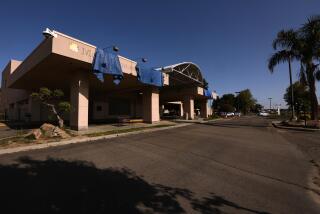Civilian Hospitals Prepare to Aid War Wounded
- Share via
Sailors, soldiers and fliers with long-term injuries from Gulf War fighting could arrive at San Diego civilian hospitals as soon as 12 hours after being wounded, under a system that includes 20 San Diego County hospitals.
The injured servicemen and women will be those who face a long road back to recovery--for instance, amputees, victims of extreme post-traumatic stress disorder, and those with debilitating head or spinal injuries.
They would be sent to civilian hospitals only after Naval Hospital San Diego and the VA Medical Center’s resources were exhausted. Still, county trauma system officials and physicians are well-organized for any military need, said Dr. Brent Eastman, director of trauma services at Scripps Memorial Hospital in La Jolla.
“We think in San Diego we are particularly well prepared to participate in such a program because of our well-organized trauma system,” Eastman said.
The county’s trauma system continues to be recognized as a national leader in effectiveness and expertise at treating people critically injured in car wrecks, shootings and other traumatic events. It sends these patients only to six hospitals, which have specialty teams on duty 24 hours a day.
Trauma system and area hospital officials were briefed privately Tuesday at the La Jolla hospital on details of the military’s plan, called the National Disaster Medical System, by representatives of Naval Hospital San Diego.
At a press conference afterward, Gail Cooper, director of emergency services for the county, said that the military put the county on standby alert for casualties Jan. 11, as the United Nations deadline for Iraq’s withdrawal from Kuwait approached.
Once attacks on Iraq began, she said, county officials were asked to make daily checks of beds available for military use. They are doing so with the existing trauma radio network, which is used to route patients to appropriate hospitals.
The 20 hospitals have agreed to make beds available for more than 500 war casualties at any one time, said John Waldron, county disaster services coordinator.
Local officials have been told the military will identify injured whose recovery will be protracted and evacuate them immediately. This would bring them to San Diego 12 to 24 hours after the injury occurs, Eastman said.
They would land at Miramar Naval Air Station, then be taken by ambulance or special buses to hospitals, Waldron said. And if the Navy ran out of transportation, civilian sources would be used, he said.
Naval Hospital spokeswoman Pat Kelly said the hospitals that have committed beds to the effort are Alvarado, Mission Bay, Valley, Children’s, Community Hospital of Chula Vista, Coronado, Green (Scripps Clinic), Grossmont, Hillside, Mercy, Mesa Vista, Palomar, Paradise Valley, Scripps Chula Vista, Scripps La Jolla, Sharp Cabrillo, Sharp Memorial, UC San Diego, Villa View and Vista Hill.
But they will not let their agreements with the government jeopardize care for their normal patient populations, Cooper said.
“That’s one of the reasons that the county EMS agency is involved,” she said. “We have to be sure that when we receive casualties coming in, that we don’t overload our hospitals such that we can’t take care of our normal emergency patients--our regular heart attack patient or trauma patient--within our system. And that’s why the hospitals are checking (resource availability) each night.”
It is expected that the number of casualties in the Gulf War would have to be more than 50,000 before civilian hospitals would be called on for help, said Air Force Capt. Tom Dolney. Dolney is a public relations spokesman for the unit at Scott Air Force Base, Ill., from where the medical system would be coordinated.
There are 14,000 beds in U.S. military hospitals and another 18,000 beds that would be available within 72 hours in VA hospitals nationwide, Dolney said. Fifty of those beds would be at the 417-bed La Jolla VA hospital.
Another 25,000 VA beds could be in use within 30 days after casualties began to arrive, and military hospitals also could be expanded quickly to take as many as 50,000 patients.
The number of casualties military hospitals could handle depends heavily on how well they can be staffed with reservists. Most of their active-duty physicians, nurses, technicians and therapists are overseas.
For instance, the 762-bed Naval Hospital near Balboa Park lost 600 medical staffers to the Mideast deployment, but has received only 300 reservists to replace them, said H. Sam Samuelson, a Navy spokesman. Total staffing as of Tuesday was about 400.
More reservists are arriving every day, but there are still shortages, said Naval Hospital spokeswoman Kelly said.
A lack of anesthesiologists prevented any surgeries at Balboa until recently, when a Defense Department medical contractor, Partners Health Plans, provided civilian doctors to staff two operating rooms, she said.
Likewise, if shortages in the civilian sector are an indicator, staffing problems might be expected in areas such as orthopedic surgery and intensive-care nursing.
More to Read
Sign up for Essential California
The most important California stories and recommendations in your inbox every morning.
You may occasionally receive promotional content from the Los Angeles Times.













